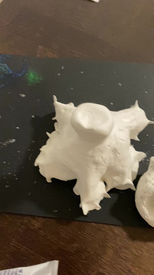

Art for Soul
"Art for Soul" is a transformative initiative designed to introduce refugees to the rich and diverse cultural life of Finland while simultaneously fostering creativity and improving the well-being of individuals of all ages through the art. This project recognizes the therapeutic potential of art and seeks to harness its power to create a positive impact on the lives of refugees and the wider community. It aims to promote social integration, cultural exchange, and enriching lives.
Designed for the Finnish Red Cross Reception Center in Raahe.
Project objectives
Integration
The project aims to facilitate the cultural integration of refugees by introducing them to the rich cultural heritage of Finland.
Through workshops and cultural immersion, museum tours, and discussions participants gain a deeper understanding of Finnish traditions, art, music, and customs.
Creativity Development:
The project provides a safe and nurturing environment for all participants to develop their artistic skills and express themselves through various art forms.
The age differ from 9 months to 78 years old.
Creativity is a skill that you can develop while practise.
Well-Being Improvement
Engaging in creative activities help reduce feelings of isolation, anxiety, and stress while promoting self-confidence and a sense of purpose, uniting families and strangers who have to live in a new and unknown living environment.
Art therapy is one of the smoothest and most effective ways of dealing with PTSD.

Art practices has been widely recognized as an effective tool in reducing PTSD symptoms, lowering stress levels, and improving emotional well-being, particularly during periods of adaptation such as relocation. Studies show that art creation reduce symptoms of anxiety, stress and depression by up to 73%*, helping individuals process trauma in a non-verbal, therapeutic environment. For refugees, art therapy not only facilitates emotional healing but also enhances adaptation to new cultural contexts by fostering self-expression, building resilience, and promoting social integration. Engaging in art has been shown to significantly lower cortisol levels and improve overall mental health.
* Source
Program structure and implementation
The sessions were divided into two groups: adults and parents with children.
In the later stages of the project, older kids started to join the sessions without their parents.
-
The adult sessions were art therapy-oriented, focusing on addressing PTSD, rebuilding life from the ground up, and fostering communication with both family members who remained in their homeland and those who arrived with them. The sessions incorporated a diverse range of methods, including movement-based therapies, art therapy, cultural tours, photography, creative writing, crafting, relaxation and meditation, sound healing, therapeutic film viewings, reflective discussions, and wellness practices.
-
Recognizing that children often internalize their emotions and become withdrawn, these activities helped them gradually open up in a safe, nurturing environment. The sessions incorporated movement-based practices, eco-art techniques, clay modeling, and nature interactions to engage their senses and bring them into the present moment. As children became more comfortable, they participated in creative storytelling, drawing, doodling, collage-making, theater games, and guided meditations designed specifically for children. These activities encouraged self-expression, helped them process their emotions, and developed their communication and creative thinking skills, while also fostering a sense of belonging within the group.
Our customers were from all around the world including Ukraine, Palestine, Iran, Bolivia, Venezuela, Somalia, Afghanistan and others. The sessions were arranged in 3 languages simultaneously: English, Finnish and Russian.
The total amount of participants was over 70 people. The duration was 1,5 years of weekly 2-hour meetings for each group. Age from 8 months to 73 years old.
Finland has become a home for many refugees from diverse backgrounds seeking safety and a new beginning. While the country has been successful in providing refuge, the journey of social integration, especially through cultural assimilation, can be challenging. Refugees often face the struggle of adapting to a new culture and the burden of leaving behind their artistic heritage. "Art for Soul" became a bridge between cultures, fostering a sense of belonging and self-expression, regardless of one's background.
Program Structure for Adults: A Three-Stage Therapeutic Journey
The Art for Soul program for adults was structured into three distinct art therapy stages, each designed to address the unique emotional and psychological needs of the people who had to forcefully relocate to another country.
Stage 1: Stabilization and Grounding
The first stage focused on stabilization and grounding, particularly crucial for individuals who had just arrived in a new environment, many of whom were still coping with fear, disorientation, and symptoms of post-traumatic stress disorder (PTSD). The workshops during this stage were designed to provide a sense of safety and security, using calming and grounding techniques to help participants reconnect with the present moment. This phase allowed them to express their initial emotions in a non-verbal, supportive environment, fostering trust and stability. During this stage we worked with supportive techniques, using our bodies, relaxation methods, and containment. We talked less, slowly building a safe space for manifestation and self-expression.
Stage 2: Emotion Recognition and Processing
Once participants had achieved a more stabilized condition, the program moved into the second and most crucial stage: emotion recognition and processing. This phase, lasting eight months, centred around gently helping participants explore and express their emotions through projective art therapy methodologies. The work was deliberate and gradual, as there was a significant risk of regression to the previous stage if emotional processing became overwhelming.
At this point, group cohesion and support were essential. Participants needed to feel connected with each other, and we ensured that the group environment was carefully facilitated, with clear rules and a deeply supportive atmosphere. The group dynamic was nurtured with care, ensuring that the process unfolded in an ecological, sustainable way. During this time, participants began to articulate their unspoken emotions, and the focus was on fostering emotional resilience, group trust, and self-expression.
Stage 3: Goal Setting and Future Planning
The final stage of the program was about goal setting and life reintegration. As participants gained emotional strength and stability, the focus shifted toward finding purpose, setting personal goals, and preparing for real-life situations. This phase emphasized personal development and forward-thinking, as participants began to make educational or career plans to help them integrate more fully into Finnish society.
Practical activities included exploring the local neighbourhood, cultural tours of Oulu, and visits to galleries and museums. Participants became more future-oriented, focusing on building a life in Finland with confidence and self-efficacy.
Throughout all stages, the integration of Finnish cultural norms, traditions, and social practices became prominent. We celebrated Finnish holidays, listened to local music, discussed daily routines, and explored the legal and cultural framework of life in Finland. Simultaneously, our goal was not to replace the unique cultural background that they carry but to enrich it with new ceremonies and traditions.
Sessions for Adults
Program Structure for Children with Parents group
The sessions for parents and children were designed with an emphasis on joint participation, requiring the presence of parents to foster a deeper emotional bond and aid in reuniting families affected by the stress of relocation. These sessions weren’t solely about assisting children with their activities but aimed to re-establish a nurturing and secure environment, as children often do not express their emotions openly. Instead of verbalizing or crying like adults, many children become withdrawn, shy, and introverted. In times of upheaval, it is essential for parents to remain closely involved in their children’s lives, creating a safe space filled with care and support. However, due to the emotional toll of relocation, parents often struggled to provide this at home due to depleted psychological resources.
For the first six months, sessions required the parents’ presence as we built a secure, emotionally supportive space where children could slowly open up and engage with others while spending meaningful time with their parents. Many parents discovered hidden talents in their children that had previously gone unrecognized, making this period both engaging and inspiring for families. The primary focus during this stage was stabilization and grounding, as well as fostering group cohesion and creating a community of trust. We engaged in outdoor games, nature-based activities, eco-art techniques, crafting, and using clay to reconnect participants with their senses and the present moment.
In the second phase, as children became more comfortable, older children felt confident enough to engage in activities independently. They began to express their emotions more openly, interact with peers, and become more curious and active. This phase incorporated creative storytelling, fairytail creation, fine arts such as doodling, drawing, and collage-making, theater games, and interactive guided meditations tailored for children. These activities nurtured their self-expression, boosted their confidence, and helped them develop creative thinking and communication skills in a supportive, safe environment.
Sessions for Children

Photosessions
Photo sessions became a great addition to the healing and recovery process during adaptation. People accept their presence in a new environment, prepare and apply makeup, and choose clothes from the existing outfits. For women, it's very important to feel beautiful again. Even if people are not planning to stay in the country, it is becoming a nice memory of some special moments in Finland and its beautiful nature. It makes the connection with the place, people and brings to the present moment.
 |  |  |  |
|---|---|---|---|
 |  |  |  |
 |  |  |  |
 |  |  |  |
 |  |  |  |
 |  |  |  |
 |  |  |  |
 |  |  |  |
 |  |
Program Completion and Legacy
The Art for Soul project ended in December 2023 due to financial challenges, which also led to the eventual closure of the Finnish Red Cross Reception Center in Raahe. However, the impact of the program was lasting.
Seventy-five percent of the participants remain in Finland, actively learning the language, studying, working, and living happy, fulfilling lives. Despite its conclusion, Art for Soul left a legacy of empowerment, healing, and cultural integration for the participants it served.
Feedback

If you’re inspired by the Art for Soul initiative and would like to develop, design, and implement similar projects within your organization, we’d love to collaborate with you! Together, we can create impactful art therapy programs that promote emotional healing, cultural integration, and well-being for immigrants or other communities in need.
Contact us today to explore how we can bring the transformative power of art to your organization and make a lasting difference. Reach out to us and let’s start building something meaningful together!


















































